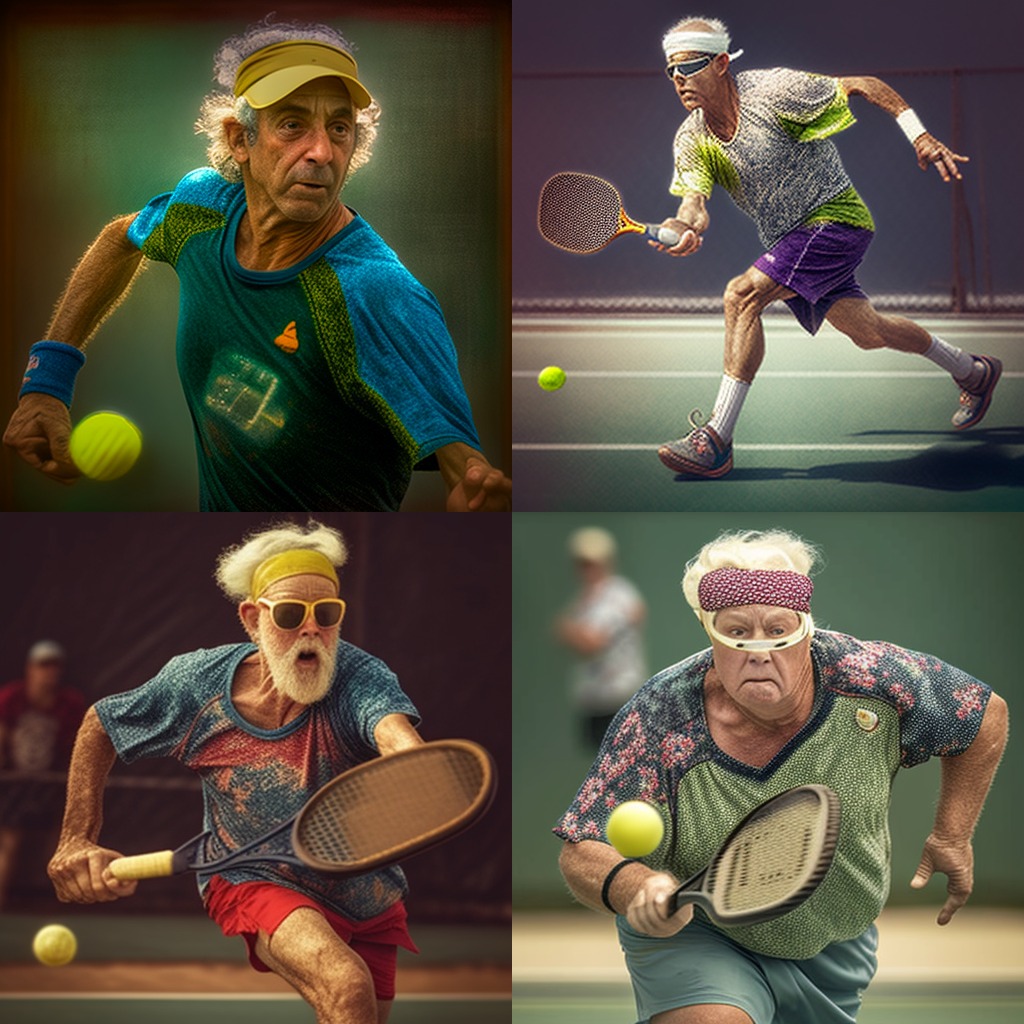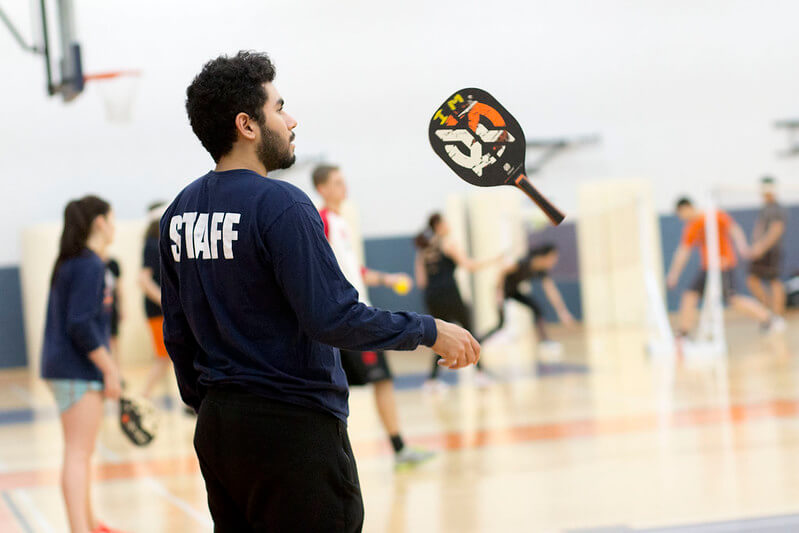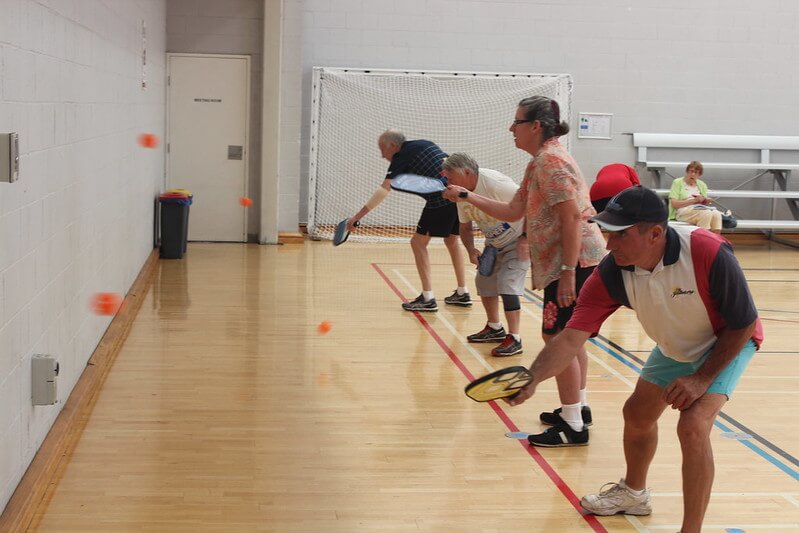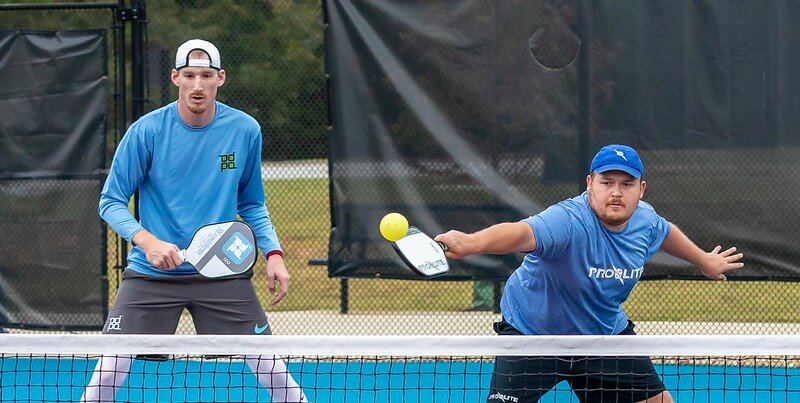
The best pickleball drills for beginners are those that improve the basics of the sport.
Pickleball is a great sport for players of all ages, and it’s beginner-friendly. New players who are looking to improve should focus on beginner drills that will train their muscles, form, and control. With practice and repetition, you will get more comfortable and be able to make more powerful shots.
Let’s take a look at some pickleball drills that beginners should definitely consider when trying to improve their skills.
Best Pickleball Drills for Beginners — What You Need

Before we begin, let’s first go over everything we need to make these drills as effective as possible.
- Friend — Having someone to play and do the drill with is important. You can critique each other, push each other’s limits, and teach each other what you’ve learned. It’s also useful to have someone else on the other side of the court to receive your shots and vice versa
- Flat Wall or Rebounding Net — If you don’t have a friend to play with, a flat wall or rebounding net will do the job. This is so that the pickleball ball will return to you easily, so you won’t have to keep chasing after the ball after you’ve hit it
- Cones — Cones are versatile and can be used for footwork training, accuracy, and even as a stand-in for the edges of a pickleball court when you don’t have a court available.
- Pickleball balls — Many balls are very useful when it comes to drills. This means you can keep hitting ball after ball without having to pick up all the balls as often.
Don’t worry if you’re missing some of these. You can always practice strokes without hitting the ball, do footwork exercises without markers, and so on.
At the end of the day, if you want to improve, there’s always something you can do.
The Basics – How to Hold the Paddle and Hit the Ball
A crucial part of improving your game is making sure that you’re holding the paddle and hitting the ball properly.
This means understanding how to grip the paddle, where your feet should be when you hit a shot, keeping your body balanced for maximum power, and developing good technique with both your forehand and backhand strokes.
There are three different ways to grip a paddle: Eastern, Western, and Continental. The Eastern grip is the most common, so we’ll focus on that.

Simply grip the paddle with the same hand form as a handshake. The orientation of the paddle should be vertical, kind of like a sword.
Once you have your hand in the right place, try swinging forehand and backhand strokes. If it doesn’t feel comfortable to you, check out our article on the three different ways to grip a paddle and find a grip that’s comfortable for you.
Forehand and Backhand Strokes
The forehand and backhand strokes are two of the most important shots in pickleball, so it’s essential that beginners master these skills before moving on to anything else.
Start by practicing simple strokes with an imaginary ball until you get comfortable with the motion. There are two ways to do strokes when playing pickleball, or even tennis.
Wrist Strokes
One of the most powerful muscles for tennis, badminton, and pickleball players is the wrist. A strong wrist can create a powerful strike with minimal movement, perfect for quick returns.
A wrist stroke is simply moving your hand to the back and front. It’s the same movement as revving a motorcycle, except your hand should be sideways. You can strengthen this muscle by using a water bottle of varying weight (depending on your strength) and moving that bottle back and forth.
When doing forehand strokes, keep your hand in a neutral position and flick your wrist forward. Imagine hitting a ball with this flicking motion. I recommend starting slowly so that you don’t pull a muscle at first. But, as you improve, your wrist will flick faster and more powerfully.

For backhand strokes, move your arm to the front and the other side of your body. If you’re right-handed, your hand should be close to your left leg, and vice versa if you’re left-handed. Start from a neutral position and flick your wrist backward.
Arm Strokes
An arm stroke means using your entire arm, all the way from the shoulders. This is much stronger than a wrist stroke but takes more time to do.
A forehand stroke starts by stretching your arm backward. Your hand should start behind your back, and in a swatting motion, move to the front of your body. Backhand strokes start with the hand near the shoulder. If you’re right-handed, your hand should be in front of your left shoulder with your arm crossing your chest. Swat your hand forward and repeat.
Pro Tip: Use Your Hips
The best way to add power to your shots is by using your entire body when you can. And, the secret to doing this is by using your hips. Your hips will rotate your body, adding more power to each of your strikes.
Once you do this, try adding some spin to your shots by angling your wrist slightly as you hit the ball. This will help add more power and control into each shot while also allowing you to stay in control of the court better.
Paddle Control and Precisions
A great way to improve your paddle control is by practicing drills like the three-bounce drill, lunge drills, and the behind-the-back drill, players can work on honing their skills.
Three-Bounce Drill
The three-bounce drill focuses on maintaining control of the paddle as you receive, execute and return high-quality shots. The idea is to hit the ball across the net and make sure it bounces three times before the opposing player can return it. Unfortunately, you will need another player to do this effectively.
Lunge Drills
The lunge drills are designed to help players learn how to take quick steps or lunges to stay with the ball. It promotes flexibility and muscle memory, for when you need to take a lunge at a ball that’s far away.
Here’s how:
- Stand with your feet hip-width apart and your toes pointing forward.
- Step forward with one foot, lowering your hips until your back knee almost touches the ground.
- Push off your front foot and return to the starting position.
- Repeat with the opposite leg.
- Aim for 10-15 repetitions per leg.
Reaction Time
Drilling is an important part of improving your reaction time. By training on drills specifically focusing on how quickly you can react to throws and shots, you can significantly improve your overall game performance.

A simple drill you can do is to have your partner lob the ball in your direction. Close your eyes and only open them when you hear the ball getting hit. Of course, tell your partner to not hit your face with the ball intentionally.
Another drill you can do is to have your opponent throw you three shots in succession, with you having to return all three on time and properly. This drill encourages quick reflexes so that players can react quickly enough during gameplay situations where they need to be prepared for anything thrown at them at any given time.
Incorporating drills into your pickleball practice routine will greatly help improve your reaction time and make you a more competitive player.
Footwork
Footwork drills are incredibly important for pickleball players of all skill levels. Drills that are designed to challenge and improve footwork help the player have more control over their shots, as well as cover a larger area of the court.
For example, fast footwork can help a pickleball player move quickly into position to volley the ball or make a backhand shot. Additionally, great footwork makes players more stable, and even allows them to draw more power into each shot.
In addition, drills that practice lighter footwork can help players execute a delicate drop shot gracefully. When drills combine both fast and light movements, it provides pickleball players with the ultimate tools they need to succeed on the court!
Techniques & Drills
Once players have mastered these basic skills, they can move on to more techniques such as dinking, blocking, and volleying drills which help improve overall accuracy and agility when playing competitively against opponents.

Dinking involves short strokes that are used mostly during defensive play whereas blocking involves using longer strokes when trying to defend against an offensive attack from an opponent attempting to score points by hitting winners off of blocked shots.
Here’s how:
- Start by standing at the non-volley zone line (the area within 7 feet from the net) facing your partner who is positioned at the baseline.
- Toss the ball up and hit a soft dink shot toward your partner.
- Your partner should return the shot with a soft dink of their own.
- Repeat the drill, focusing on making consistent and accurate dink shots.
- Gradually increase the speed and difficulty of the shots to challenge yourself.
- Practice both forehand and backhand dinking.
- After a few minutes, switch positions with your partner and repeat the drill from the baseline.
- Keep practicing until you feel confident and comfortable with your dinking skills.
Remember, the key to successful dinking is to keep the shots low and slow, with minimal spin and power. The goal is to create a difficult shot for your opponent to return.
Triangle Dinks
Dinking is one of the best ways to stay in control of a match so it’s important for beginners to practice this skill early on in their pickleball journey.
The triangle dink drill is perfect for helping players develop accuracy with their dinks while also training them how to move around quickly after each shot they make.
Here’s how:
- Start by positioning yourself at the non-volley zone line with two partners positioned at the baseline, forming a triangle.
- Toss the ball up and hit a soft dink shot to one of your partners.
- The partner you hit the shot to should return it with a dink shot to the other partner.
- That partner should then return the shot back to you with a dink shot.
- Repeat this process, focusing on making consistent and accurate dink shots.
- Gradually increase the speed and difficulty of the shots to challenge yourself.
- Practice both forehand and backhand dinking.
- After a few minutes, switch positions with one of your partners and repeat the drill.
- Keep practicing until you feel confident and comfortable with your triangle dinking skills.
This drill helps players learn how to hit accurate dinks while also teaching them how to move effectively without losing sight of where their opponent is at all times.
The Benefits of Pickleball Drills
Pickleball drills are one of the best benefits of becoming involved in the sport. Drills focus on the proper technique and conditioning needed to play pickleball at its highest level. Dynamic drills help improve coordination and agility while strengthening basic pickleball skills.

Improving your drill exercises will help you develop better control over your shot selection and court strategies. With an increased ability to move around the court quickly and vertically, you can boost your game within each match. Ultimately, the benefits of engaging with pickleball drills will help you reach your goals and take your pickleball skills to the next level!
Conclusion
There are plenty of pickleball drills out there for beginners but these are some great ones that anyone can start using right away! Remember that practice makes perfect so don’t give up if something doesn’t come easy at first.
Keep working hard and soon enough those improvements will come! And remember above all else, have fun! Pickleball should always be enjoyable so don’t let yourself get too caught up in trying too hard or taking things too seriously. Just enjoy every second on the court! Good luck!